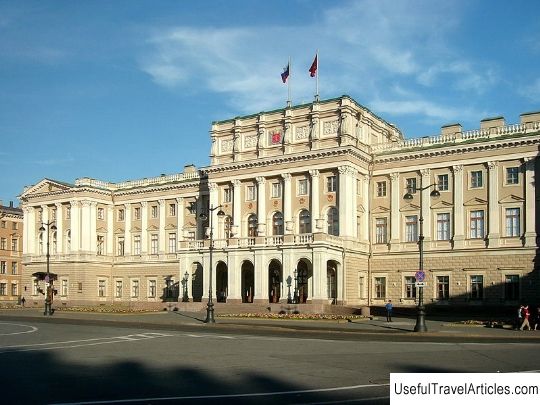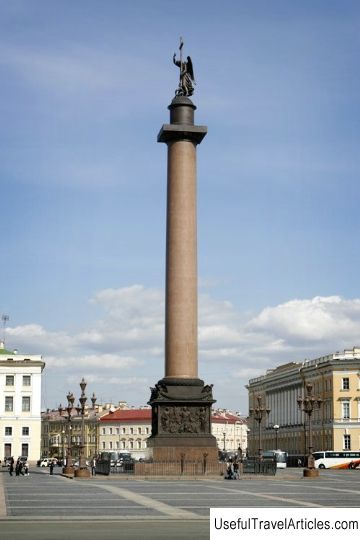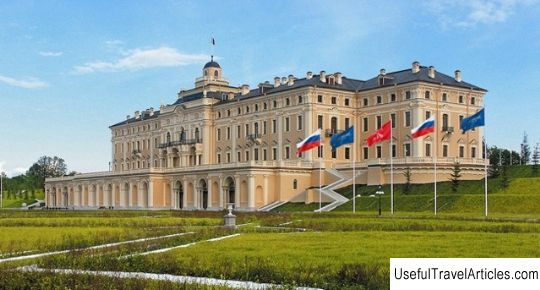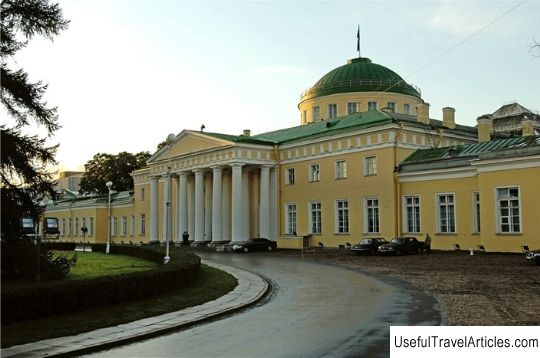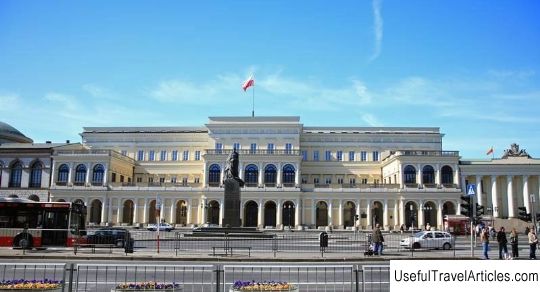Palace Square description and photo - Russia - Saint Petersburg: Saint Petersburg
Rating: 8,5/10 (8906 votes) 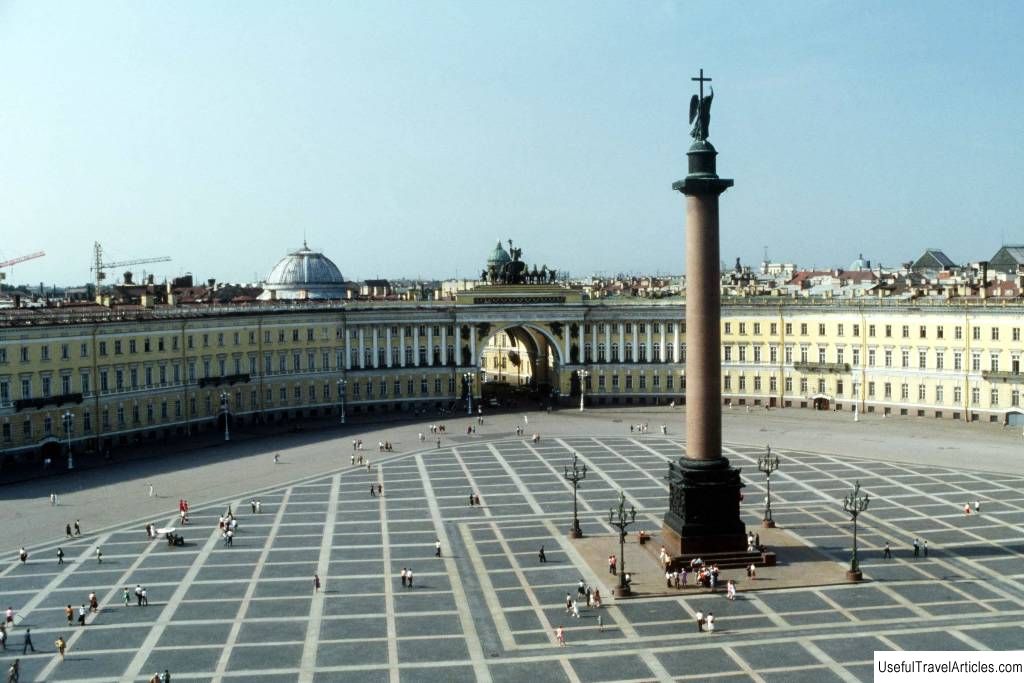
Palace Square description and photos - Russia - Saint Petersburg: Saint Petersburg. Detailed information about the attraction. Description, photos and a map showing the nearest significant objects. Photo and descriptionOne of the symbols of St. Petersburg and one of the most visited tourist places of this city - Palace Square. This architectural ensemble began to take shape in the second half of the 18th century, its formation was completed in the first half of the 19th century. The square is formed by several historical and architectural monuments - the Winter Palace (this landmark gave the name to the square), the Headquarters Building of the Guards Corps , the semicircular General Staff Building and, of course, the famous Alexander Column. The area is approximately five and a half hectares. In some sources, you can find information that its size is eight hectares, but this is not true. The area is under the protection of UNESCO: it was included in the World Heritage List. How it all began ... In the early years of the 18th century, a shipyard fortress surrounded by ramparts was founded in the city. Also, a moat was dug around the fortress, in front of which there was a space free from any buildings. Its dimensions were enormous. This space was necessary for defense purposes: in the event of an enemy attack on the fortress from the land side, it would help the artillerymen to repel the attack. But a short time after the fortress was completed, it lost its military significance. And with it, the open space behind the moat lost it. On this vacant territory, they began to store lumber needed for various construction works. It also contained large anchors and other supplies related to shipbuilding. Part of the territory was occupied by the market. By that time, the space, which once had a defensive value, was overgrown with grass and became a real meadow. Several more years passed and the territory changed again: new streets passed through it in three beams. They divided the territory into several parts. Then a new period in the history of the future famous square began. At this time, it was used as a place for folk festivals. Fireworks sparkled over it, fountains gushed on it, in which there was wine instead of water. In the 40s of the 18th century, the tsar's command was issued, according to it, on the future square (which at that time was still a meadow) followed sow oats. Later, the court cattle grazed in the meadow. Sometimes soldiers were drilled here. At that time, the Winter Palace was being completed and rebuilt, and the open space in front of it was often used for construction purposes. In the middle of the 1860s, a kind of knightly tournament took place on this space. It was a grandiose celebration, especially for which a temporary round theater without a roof was built of wood. The attire of the participants of the holiday amazed with luxury. From meadow to parade groundIn the late 70s of the 18th century, at the behest of the Empress, the process of transforming the square began. A project competition was held, after the announcement of the winner, construction work began. At the end of the century, the square looked like this: a huge space was surrounded by houses on three sides and, according to the testimony of contemporaries, it resembled an amphitheater. At the beginning of the 19th century, the architect Anton Moduy proposed a plan for the redevelopment of the square. It is on this plan that the square for the first time takes on the outlines that are now so familiar to us. In the first half of the 19th century, the appearance of the square was gradually changing, transforming. In the 30s, a famous column was erected in its center. At the beginning of the XX century (as well as in the XIX century), military parades and reviews were often held on the square. One of the darkest pages in the history of the square was the event that was later named "Bloody Sunday". The procession of workers was dispersed on the square, carrying a petition to the tsar with economic and political demands. During the dispersal of this demonstration, hundreds of people died: firearms were used against unarmed demonstrators. In the early years of the 20th century, all buildings on the square were painted brick-red, which seemed to be a harbinger of the events of 1917. In the 40s of the XX century, the buildings were returned to their original appearance: their walls were repainted in light colors. Soon after the revolutionary events, a monument to the writer and philosopher Alexander Radishchev was erected on the square. The bust was made of plaster. After standing for about six months, he was overturned by a gust of strong wind and has not recovered since then. In Soviet times, parades and festive demonstrations took place on the square. In the first post-revolutionary years, large-scale theatrical performances on a revolutionary theme were staged on this territory. In the early 30s, the square was reconstructed: the paving stones were removed, the space was asphalted; the granite pillars that surrounded the famous column have also been removed. In the 40s, the idea of transferring the column and device to the airfield area was considered. But this plan was not implemented. In the 70s, reconstruction work was carried out on the square again. The asphalt was replaced with paving stones. Lanterns were installed at the corners of the square. Square in the XXI centuryAt the beginning of the XXI century, restoration work took place on the square, during which an archaeological find was made - the remains of an outbuilding that belonged to Anna Ioannovna. More precisely, the foundations of this building were found - once luxurious, consisted of three floors. The archaeological find was carefully studied, many photographs were taken, after which it was again covered with earth. Several years later, the Alexander Column was restored. On the territory of the square, social and sports events are often held, concerts of famous performers are organized. In winter, an attempt was made to turn the square into a skating rink with a paid entrance, but this caused indignation of many public organizations and the skating rink ceased to exist. Relatively recently, a pavilion with mirrored walls was installed on the square, in which the entire architectural ensemble was reflected. This pavilion did not last long: it was destroyed by a gust of wind and then dismantled. The architectural ensemble of the square- The Winter Palace is another important part of the square's ensemble. It was built in the middle of the 18th century. The author of the project is Bartolomeo Francesco Rastrelli. The palace was built in accordance with the canons of the Elizabethan Baroque (facades and rooms are distinguished by magnificent decoration). The building was originally the residence of the Russian rulers, where they spent the winter months. In the second half of the 30s of the 19th century, a terrible fire broke out in the palace, which could not be extinguished for several days. The property rescued from the palace was piled around the famous column. At the end of the 30s of the XIX century, the palace was restored. During the Soviet era, the building housed exhibitions of the State Hermitage. - In the eastern part of the square is the building of the former Headquarters of the Guards. The author of the project is the artist and architect Alexander Bryullov. The building was built in accordance with the canons of the late classical style. Thanks to its elegance and severity, it perfectly fit into the architectural ensemble, which was very difficult: on one side of the Headquarters there is a Baroque palace, on the other - an Empire-style building. The headquarters was built in about six years: construction work began in the second half of the 1830s and was completed in the early 40s. Several years before the development of the project and construction of the building, there was an idea to build a theater on this site. This idea was never implemented. - The General Staff building rises on the south side of the square. It was built at the beginning of the 19th century. The author of the project is the architect Carl Rossi. Three buildings of the building form an arc, the length of which is five hundred and eighty meters. The buildings are connected by a triumphal arch. It is crowned with a sculptural group depicting the chariot of Glory. The architects of this group are Vasily Demut-Malinovsky and Stepan Pimenov. In pre-revolutionary times, the buildings housed not only the General Staff, but also three ministries. In the first post-revolutionary years, the building housed the People's Commissariat for Foreign Affairs of the RSFSR. Later, the usual police station was located here. At present, it houses the Headquarters of the Western Military District, which occupies part of the building. The wing, located on the east side, was transferred to the State Hermitage in the early 90s of the 20th century.              We also recommend reading Botanical Garden description and photo - Russia - Far East: Vladivostok Topic: Palace Square description and photo - Russia - Saint Petersburg: Saint Petersburg. |
